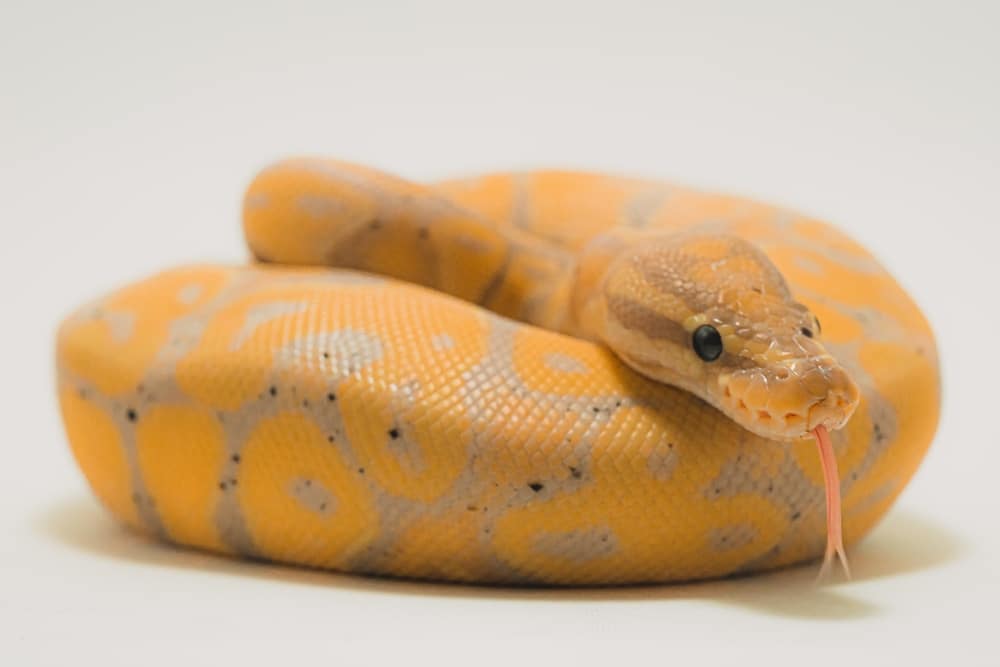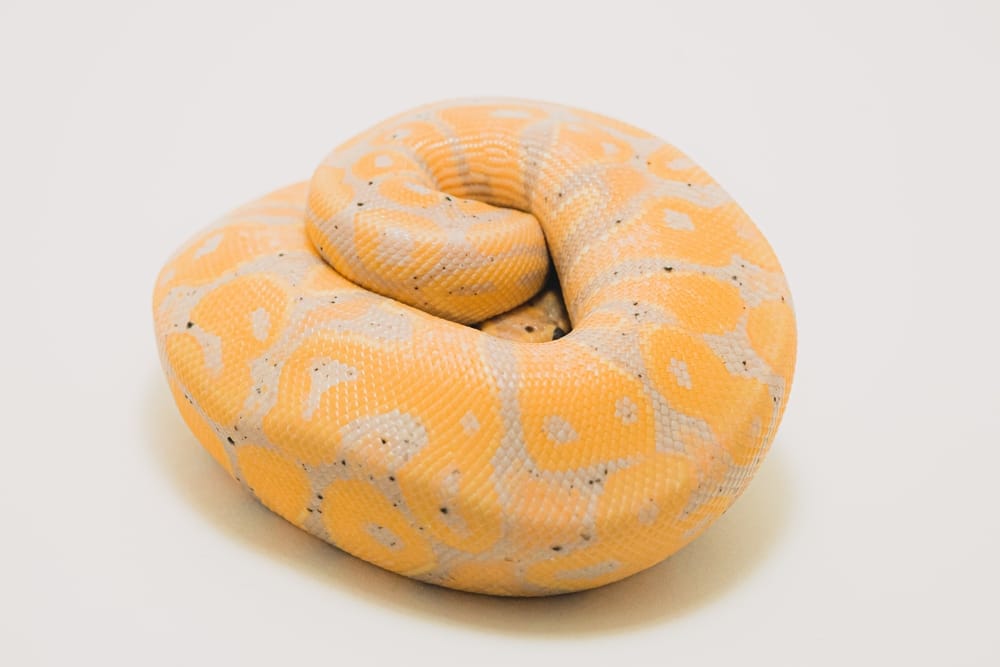In the late 1990s reptile exporters discovered a couple of strange-looking Ball Pythons in West Africa. Their base coloration was yellowish orange, with the typically black patterns reproduced in a lilac-tinted gray.
These strange snakes were purchased by American ball python breeders for large sums of money. Years of careful breeding proved this was a genuine morph – not just an aberrant mutation but one which could be inherited.

In 2003 the offspring of these wild-caught snakes finally became available as “Coral Glows” or “White Smokes.” For years they were among the most coveted and most expensive Ball Python morphs available. In 2003 the first Coral Glow sold for over $25,000. Today the morph has become better known as the Banana Ball. And while the Coral Glow would set you back more than a box full of coral jewelry, you can now get a Banana ball python for as little as $150. But though they are much less expensive, Banana balls are still just as beautiful as they ever were.
If you want to breed new morph combinations – or if you just want a gorgeous snake – you may want to pick up a Banana Ball. But the Banana mutation works in some very interesting ways, and you may want to learn more about those quirks before adding Banana balls to your collection.
This article will explain more about the Banana ball python morph, so you can decide for yourself if Banana balls are right for you.
Quick Navigation
Banana Ball Python Morph Appearance
Normal ball pythons have a brown base coloration. A Banana ball’s background comes in different shades of yellow and yellowish-orange. A very light-colored young Banana ball can be mistaken for an albino. But the Banana ball has dark-colored eyes where an albino’s eyes are red.
The Banana ball mutation causes the snake to produce very little melanin. Instead of the black pattern of a wild-type ball python, the Banana ball’s patterns can range from a very light cool gray to a beautiful pale mauve. Their color can be difficult to capture in photos but is impossible to forget once you see it.
The Banana ball’s pattern generally resembles that of a normal ball python, except for a sprinkling of small black speckles. As a Banana ball ages it, like a banana, tends to become more spotted. One major American breeder passed on a chance to buy the first Banana balls captured when he saw their photos and assumed that they were covered with ticks.
The Banana mutation is not associated with any of the birth defects found in some ball python morphs. Outside their striking coloration, most Banana balls will be as healthy as a normal ball python and will have identical care requirements. You should have no trouble breeding your Banana balls once they come of age. But there are a few things you should know first.

Genetics and Pattern of Inheritance
Many popular ball python morphs are recessive. When a Piebald ball python mates with a normal ball, the offspring will look normal but carry one copy of the Piebald mutation. If those “het Piebald” snakes are later bred to a Piebald, they will produce 50% Piebalds and 50% het Piebalds.
(Please note that the actual number of normal offspring and morph offspring can vary with each clutch. Over a greater number of breedings the percentages will move toward the mean. But any given pairing can produce a disproportionate number of morph or non-morph babies.)
When a Banana ball is mated to a non-Banana ball, half of the offspring will be Banana balls. The other half will be normal balls who do not carry the Banana gene. If a Banana ball is mated with another banana ball, one-quarter of the offspring will inherit the normal gene from both parents. Half of them will be banana balls. And one-quarter will be Super Bananas.
A Super Banana is lighter in color and its patterns are less defined: some say a Super Banana looks like a Banana in permanent shed. But while they may not be as visually appealing as Bananas, Super Bananas have two Banana mutations. As a result, 100% of their offspring will be Banana balls.
This can come in very handy if you want to make morph combinations. A Super Banana bred to a Spider will produce half a clutch of Bananas and half a clutch of Banana Spiders. A Super Banana bred to a Piebald will produce a clutch of Bananas het Piebald. When they are mated with Piebalds, you can expect 25% of their offspring to be Banana Piebalds.
It would seem that the Banana ball is a snake breeder’s dream. But the simplest dreams are often complicated by unexpected realities.
Potential Problems: Male-Maker and Female-Maker Banana Balls
In June 2011 female Banana balls cost $12,000-$20,000 and male Bananas were going for $60,000. The breeders who invested in the first captive bred generations found that their breeding efforts were producing a disproportionately large number of Banana females, with few Banana males being produced.
A female Banana’s clutch will typically hatch both female and male Bananas. When you breed those male Bananas you will find that around 95% of the Bananas they produce will be female! 5% of Bananas produced by these “female maker” males will be male. When they are mated with a non-Banana female ball, 95% of their Banana offspring will be male. And the offspring of this “male maker” will also produce a large majority of male Bananas.
While many ball python breeders have strongly held theories on the subject, we do not know exactly how the Banana mutation works. After years of breeding Banana balls, we can be certain that this discrepancy in sexual distribution exists. If you are adding a male Banana to your breeding collection, ask the seller which parent was Banana. If his mother was a Banana, your new snake is a female maker: if his father, he will be a male maker.
If you are working on designer morphs, you may have specific plans for your future breedings. Knowing ahead of time that your Bananas will skew heavily toward a certain gender may be helpful. For most Banana ball owners, the male-maker/female-maker question is just an interesting curiosity. There is no evidence of any genetic issues associated with male- or female-maker Bananas or their offspring.
Popular Banana Ball Python Combinations
The Banana morph, like other co-dominant mutations, makes things easier for breeders. And because the Banana morph is so beautiful, it goes well with almost any other morph. Some of the most impressive combinations include:
Banana x Enchi: Enchi balls have a more orange-tinted coloration and a lighter brown pattern. Banana Enchis replace the lilac patterns with a mellow burnt orange.
Banana x Pastel: A cross between a Pastel and a Banana will produce normal, Banana, Pastel and Banana Pastel offspring in roughly equal measure. A Cinnamon Pastel Banana will have brighter oranges and yellows, while a Black Pastel Banana will have darker purples.
Banana x Piebald: White patches set off by a lilac and orange background make the Banana Piebald truly memorable.
Banana x Pinstripe: On a Banana ball the thin lines of this pattern are like bare purple branches against a sunset. And because pinstripes are co-dominant, you are likely to get at least a Banana Pinstripe on your first or second try.
Banana x Spider: The Spider’s reduced pattern combined with Banana coloration can produce a breathtaking snake. But Banana Spider balls can also be prone to “Spider Wobble,” a neurological issue with many Spider balls.
Not to be outdone, some designer Banana balls have three or even more morphs. Banana Spinners (Banana x Spider x Pinstripe), Banana Bumble Bees (Banana x Spider x Pastel) and Banana Pastel Piebalds are just a few of the possible triple morphs made with Banana balls. If you have the room and patience to breed them – or the money to buy them – there are few limits on what multi-morphed Banana ball pythons you can add to your collection.
Caring For a Banana Ball Python
Your Banana ball should provide you years of colorful companionship with a modicum of care. Like most ball pythons, they will need adequate space, a temperature gradient between 75° and 95°, a comfortable hiding space, clean living conditions and regular access to fresh water. They are generally docile. You can take them out to show your friends without fear of bites so long as everyone handles the snake gently. (And when you own something this beautiful you will want to show them off)!
If you notice that a speckle on your Banana ball is moving, they may have mites or ticks. These little parasites can make your snake miserable. There are many snake-safe sprays you can use to deal with snake mites. But it is far better to avoid exposing your snake to mites in the first place. Avoid taking your snake outside to play in your lawn as they may bring home unwelcome guests. Keep their cage clean and keep any new snake you may bring into the house safely quarantined until you are certain it is healthy and pest-free. (And if this article inspires you to bring a new Banana ball into your home, be sure you keep it away from the rest of your collection until you are sure it has no parasites or contagious diseases!)
Banana balls are as a group no less healthy than regular ball pythons. But being ball pythons, they will sometimes be reluctant to eat. Make sure you are giving them appropriately sized prey, and err on the side of caution. A ball python will generally refuse food if they don’t feel comfortable swallowing it. If they do force it down, they can regurgitate or even die. Never feed a rat to a snake with a mouse-sized appetite. And keep in mind that snakes can go months without eating, and often do in the wild.
Stress can also put ball pythons off their feed. You may want to hold your Banana ball and reassure them after they have been refusing rodents for a few weeks. Ball pythons are generally tolerant of handling, but their tolerance has its limits. A little interaction and engagement can be beneficial for snake and owner alike. But if your Banana ball is fasting you can try covering their cage with a towel for a few days. The peace and quiet may help them regain their appetite.
Conclusion
The Banana ball may be ideal for snake keepers who want to expand their ball python collection with a beautiful but relatively inexpensive morph. (But don’t be penny wise and pound foolish: the best breeders may charge more, but they also spend more on keeping their snakes healthy. The money you save buying from a less ethical dealer can quickly be eaten up by veterinary bills for your new pet and for the rest of your collection).
Do your research before buying, and don’t be afraid to ask questions. If your dealer doesn’t know the parent from which your snake inherited the Banana genes, they don’t know whether or not your new boy is a male-maker or a female-maker. And if they don’t understand why that question matters, you may do better working with a smaller breeder who loves the hobby and who will be better able to help you keep your new snake healthy and happy for years to come.
Do you have a Banana ball python? What advice would you give somebody thinking about adding a Banana to their collection? Do you have any pointers, stories or photos you would like to share? Let us know your thoughts in the comments below!